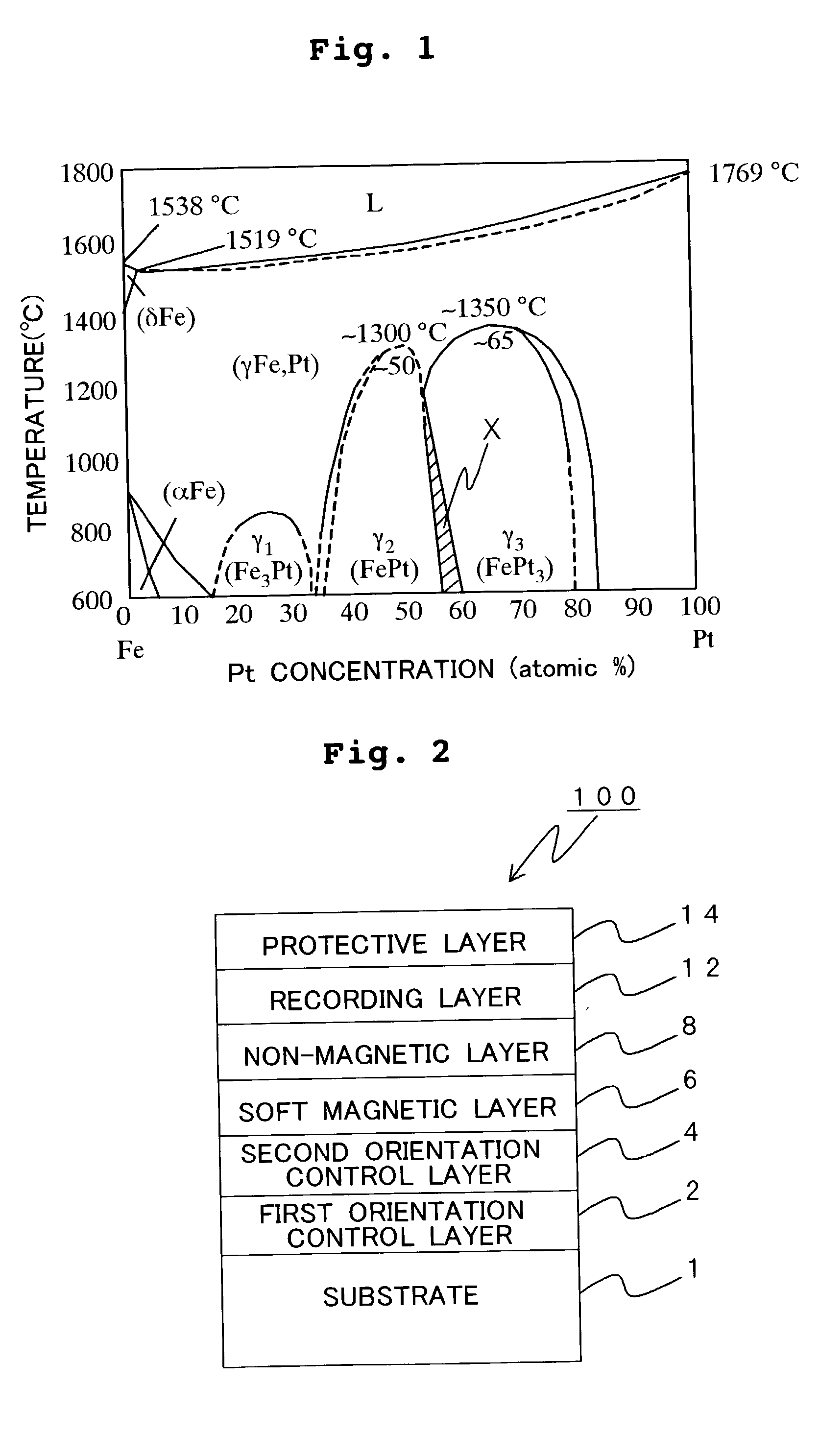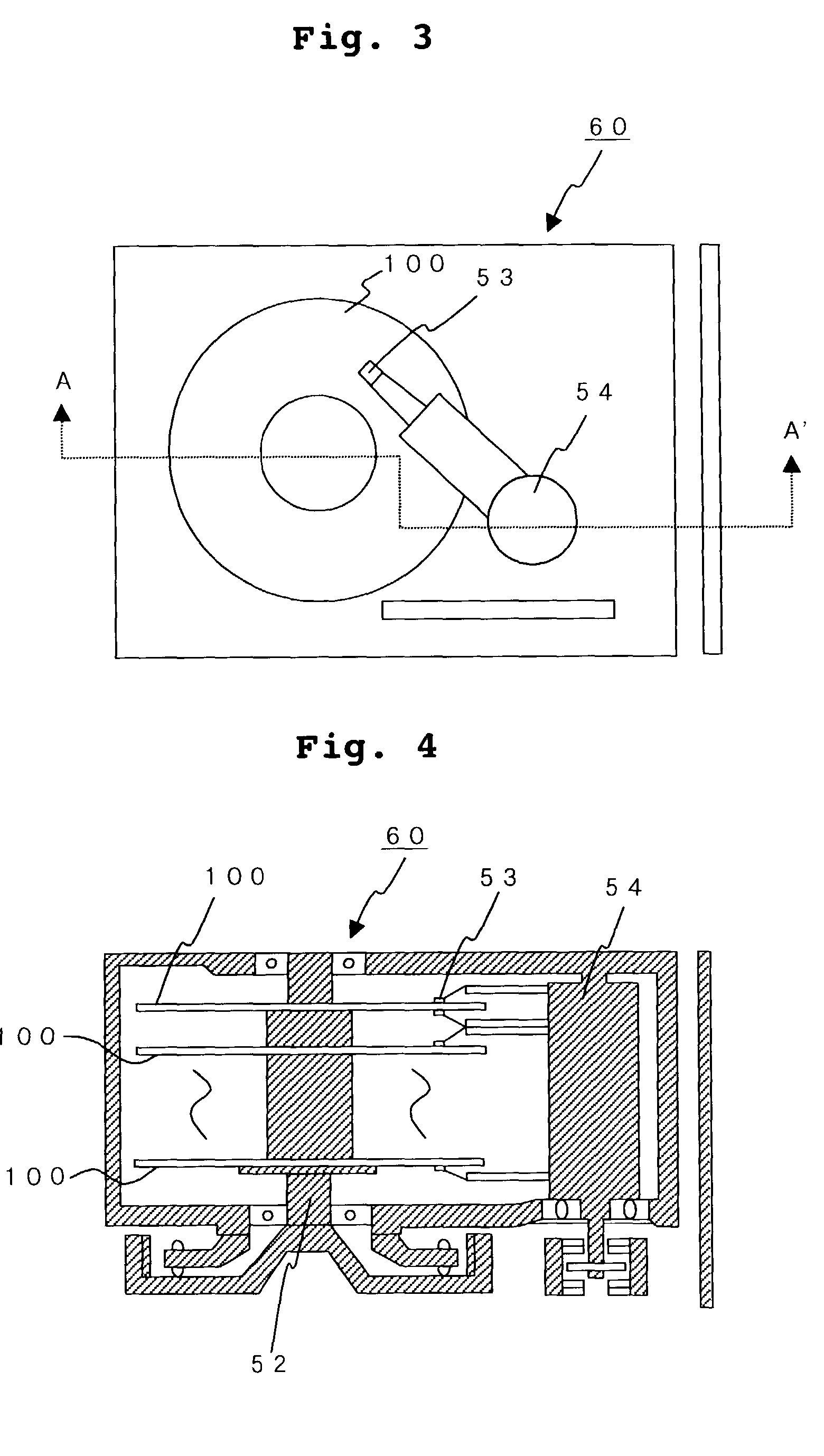[0018] The magnetic recording medium of the present invention includes the FePt ordered alloy and the FePt.sub.3 ordered alloy in the recording layer which is formed on the substrate. In this structure, the recording layer resides in a
mixed phase in which the two types of phases, i.e., the ferromagnetic FePt ordered alloy phase and the FePt.sub.3 ordered alloy phase are separated from each other. In the
mixed phase of the FePt ordered alloy phase and the FePt.sub.3 ordered alloy phase as described above, it is considered that the ferromagnetic FePt ordered alloy phase constitutes the
crystal grains, and the FePt.sub.3 ordered alloy phase constitutes the crystal
grain boundary. The FePt.sub.3 ordered alloy phase exhibits the
antiferromagnetism at a temperature of not more than -113.degree. C., and it exhibits the
paramagnetism at a temperature higher than the above. Therefore, when the magnetic recording medium of the present invention is incorporated into a magnetic recording apparatus, the FePt.sub.3 ordered alloy phase in the recording layer exhibits the
paramagnetism in the
operation temperature region (0.degree. C. to 100.degree. C.) of the magnetic recording apparatus. Accordingly, it is considered that the
magnetic interaction, which acts between the crystal grains of the ferromagnetic FePt ordered alloy phase, is broken by the paramagnetic FePt.sub.3 ordered alloy phase. Therefore, even when the recording layer is based on the use of the FePt ordered alloy which has the high crystalline
magnetic anisotropy, it is possible to reduce the
noise, because the magnetic interaction between the crystal grains is broken. Further, the magnetic recording medium is excellent in thermal stability, because it is possible to use the FePt ordered alloy which has the high crystalline
magnetic anisotropy. Other than the FePt ordered alloy, the recording layer may contain a ferromagnetic ordered alloy having high crystalline magnetic
anisotropy, for example, an L1.sub.0 ordered alloy such as CoPt and FePd.
[0020] The recording layer of the magnetic recording medium of the present invention includes the FePt ordered alloy and the FePt.sub.3 ordered alloy. When the magnetic recording medium as described above is used as a medium based on the perpendicular magnetic
recording system, the (001) plane of the FePt ordered alloy is oriented in parallel to the film surface so that the easy axis of
magnetization of the FePt ordered alloy is arranged in the direction perpendicular to the film surface. The crystalline structure of the FePt ordered alloy resides in the face-centered tetragonal lattice (hereinafter referred to as "fct") having lattice constants of 3.8525 angstroms for the a axis and 3.7133 angstroms for the c axis. On the other hand, the crystalline structure of the FePt.sub.3 ordered alloy resides in the face-centered cubic lattice (hereinafter referred to as "fcc") having a
lattice constant of 3.866 angstroms. Therefore, the FePt ordered alloy and the FePt.sub.3 ordered alloy are crystallographically compatible with each other, and they have the approximately identical lattice constants. Therefore, the FePt.sub.3 ordered alloy does not inhibit the (001) preferred orientation of the FePt ordered alloy. Therefore, the orientation can be controlled with ease for the recording layer which is formed of the FePt ordered alloy and the FePt.sub.3 ordered alloy.
[0022] The magnetic recording medium of the present invention may further comprise an
orientation control layer. The orientation
control layer makes it possible to orient the easy axis of
magnetization of the recording layer in the direction perpendicular to the film surface. Those
usable as the material for constructing the orientation
control layer may include, for example, elements such as Cr, Pt, Pd, Au, Fe, and Ni, compounds such as MgO and NiO, and alloys containing them. The orientation
control layer may be composed of a single layer. Alternatively, the orientation control layer may be composed of a plurality of
layers.
[0023] The magnetic recording medium of the present invention may further comprise a soft
magnetic layer. It is preferable that the soft magnetic layer is positioned in the medium so that the recording layer is positioned between the magnetic head and the soft magnetic layer during the recording of information. Accordingly, the magnetic path is formed between the magnetic head and the soft magnetic layer during the recording of information. Therefore, it is possible to reliably apply the
magnetic field from the magnetic head to the recording layer. The soft magnetic layer also makes it possible to control the crystalline orientation of the recording layer. It is possible to use, for example, Fe, Fe--Si alloy, and Ni--Fe alloy for the soft magnetic layer as described above.
[0024] The magnetic recording medium of the present invention may comprise a non-magnetic layer between the soft magnetic layer and the recording layer. The non-magnetic layer makes it possible to break the magnetic
coupling effected between the soft magnetic layer and the recording layer. It is preferable to use Cr, Pt, Pd, Au, Fe, Ni, MgO, or NiO as the material for forming the non-magnetic layer. It is especially preferable to use MgO which has a strong effect to avoid the
diffusion of the material caused between the soft magnetic layer and the recording layer.
[0029] The magnetic recording apparatus of the present invention makes it possible to perform the recording in a
large capacity, and magnetic recording apparatus is excellent in recording stability over a long period of time, because the magnetic recording apparatus is provided with the magnetic recording medium according to the first aspect of the present invention.
 Login to View More
Login to View More 


